William (1.3.1) Blew Property, Jefferson Co., WV
Bill Blue's "Descendants Of John Blaw (Blue) d.1757 Somerset Co., NJ, Fifth Edition" says the following about William:1.3.1 William BLEW (b.ca 1724), m. Margaret BLEW (b.1733) [1.5.1]. Lived in Somerset Co. NJ. Late in life they moved to Berkeley Co. VA and leased land about two miles west of Harpers Ferry. He leased the 201 acres in 1793 from Robert BOGGESS, then in 1800 he subleased it to John MORROW. His sons, Samuel and Cornelius, lived on this land.

William Blew, original data
| N 20 E | 118 poles |
| N 70 E | 132 poles |
| N 20 E | 50 poles |
| S 61 E | 50 poles |
| S 22 W | 301 poles |
| N 57 E | 160 poles |
William Blew leased 201 acres from Robert Boggess, who in turn leased it from Henry Lee. We have copies of the land grants for both transactions. The one for Boggess/Blue includes an interlineated correction and is a little confusing. The Lee/Boggess is clearer.
Beginning at a White Oak corner to William Graham, Whence N. 20 E 118 poles to a Locust & hiccory, then N 70 ° E 132 poles to a Black Oak, then N 20 E 50 poles to Harpers road, then with the same S: 61 E 50 poles Keyes road thence with the same S: 22 Wt 301 poles to a White Oak another Corner to Graham, thence with his line to he beginning ∼ N. 57 E 160 poles.
Both appear to include a transcription error, however, as the plat when plotted doesn't form anything like a closed figure. The first diagram and table to the right shows the uncorrected plot taken from these two documents. The reddish line is added by the program to close the figure.
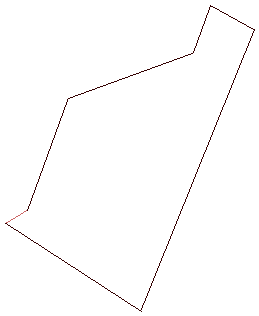
William Blew, adjusted data
| N 20 E | 118 poles |
| N 70 E | 132 poles |
| N 20 E | 50 poles |
| S 61 E | 50 poles |
| S 22 W | 301 poles |
| N 57 W | 160 poles |
The most obvious way to correct the diagram is to turn the "E" in the last line to a "W", making it "N 57 W 160 poles". The second diagram and table shows the result. This figure doesn't quite close either, but the differences here are more what you might expect from a 2 dimensional representation of a plat paced out over terrain with varying elevations.
Locating the property
Having created a map of the property, the next thing to do is to place it on a greater map of the area. I prefer to do this on a topographic map. There are several servers on the Internet which will provide topographic maps in various resolutions, and my plat program can be set to use the same resolution as any of these.
Some of the choices are:
For this case, I've chosen a 1:50,000 resolution map from TopoZone:
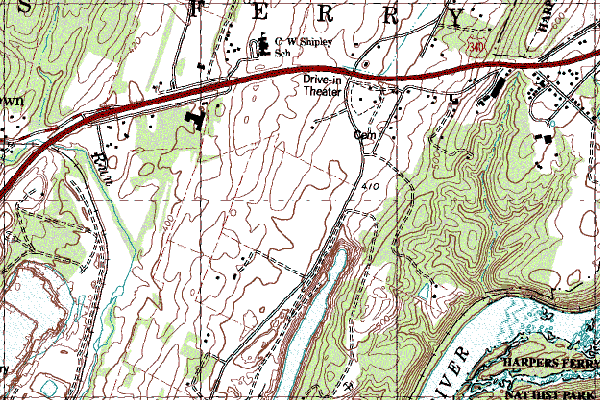

The Berkeley County Historical Society in Martinsburg, WV has a number hand-drawn maps showing 18th century property lines, created by Galtjo L. Geertsema. Each map corresponds to a USGS topographic map and is drawn to the same scale. I have transcribed a bit of the Jefferson county map to the right.
The owners listed for the various parcels are:
| Lot | Owner |
|---|---|
| 412 | Joseph McCamish |
| 410 | Thomas Maybury |
| 411 | Humphry Keys |
| 405 | Thomas M. Goldburg |
| 404 | Gershem Keys |
| 403 | Thomas Smith |
Note that the "Keyes road" mentioned in the plat may very well be named after the family who owned lots 404 and 411 (as well as other property that is outside the portion that I've transcribed.
The property lines shown in Geertsema's map and the modern USGS topographic map are quite different, but there are a few similarities, in particular the angle formed at the western end of the line between lots 403 and 404. This same angle is found in our plats above. Note the dashed red line in the USGS map.
If we combine the plat, Geertsema's map and the USGS map we get the following:
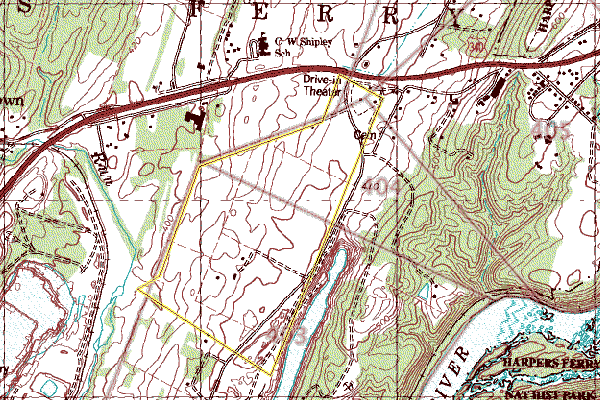
Given that early surveys were often imprecise, (as we've seen there's already one substantial error in both the Lee/Boggess and Boggess/Blue documents), it isn't unreasonable to clean up the plat a little. The East and South lines are probably over long due to the surveyor's chain following the terrain, for one thing and for another, we can be forgiven for assuming that the Harper and Keyes roads are close to some existing roads. My reconstruction of William Blew's property therefore looks something like this:
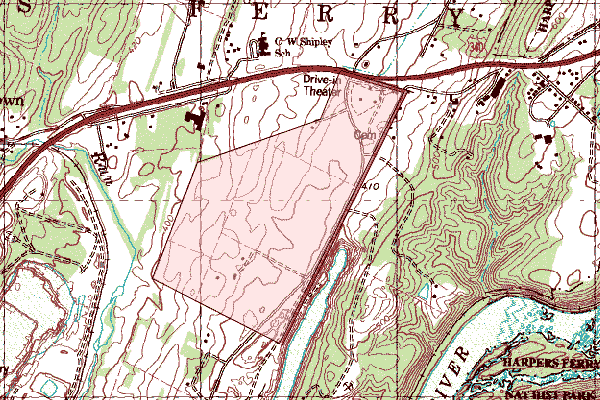
One interesting outcome is that this puts the Allstadt family cemetery, which we explored on 28 June 2004, on Blue property, leaving us with the possibility that the oldest and most defaced stones may very well be from the Blue family. The cemetery was very overgrown, and looked to have at least 20 and possibly up to 50 burial places. (Anne Braun, who visited the cemetery before us lists 18 named individuals.) There were many stones lying down on their faces and unable to be read. Other stones were completely weathered or broken. This cemetery is placed behind a stoned wall and it is very hard to see that it is a cemetery from the road. It is a true joy to visit for genealogy crazed people with a treat for those visiting in the right season of wild red raspberries.
The second interesting possibility is that the Allstadt family has a
historical marker on buildings just beyond the cemetery on the Blue
property—the
"Allstadt House and Ordinary". It is unknown at this time if these
could in fact have been originally owned or built by William Blew and his
sons, Samuel and Cornelius.

Update
After I put the above together, Bill Blue sent me an 1862 Jefferson County map that shows the ownership of the various parcels in the area. This includes two Allstadt properties, one for John H. Allstadt, and another for the heirs of Mrs. Elizabeth Allstadt. The John H. property along with that of Joseph L. Russell, appears to be part of the Bogess/Blew property.
I've merged the 1862 map in with my reconstruction of William's property and the Geertsema map. The results appear below. They continue to make me think the "Allstadt House and Ordinary" is really the ordinary that William Blew obtained a license for in 1792. The Allstadt property would appear to be across the street or well to the south of the tavern/ordinary. Interestingly, there is a "Tollhouse" listed north of the road, across from the building that would appear to be the Allstadt/Blew ordinary.
Beyond the question of the ordinary house, the 1862 map makes me wonder if the southwest property line isn't a bit further south than I drew in my reconstruction (in pink, still).
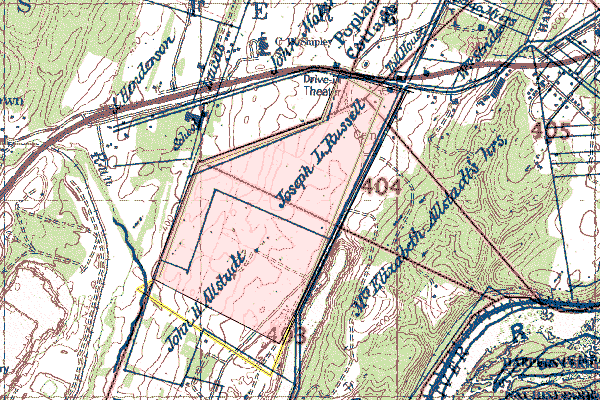
JimB.
July 1, 2004